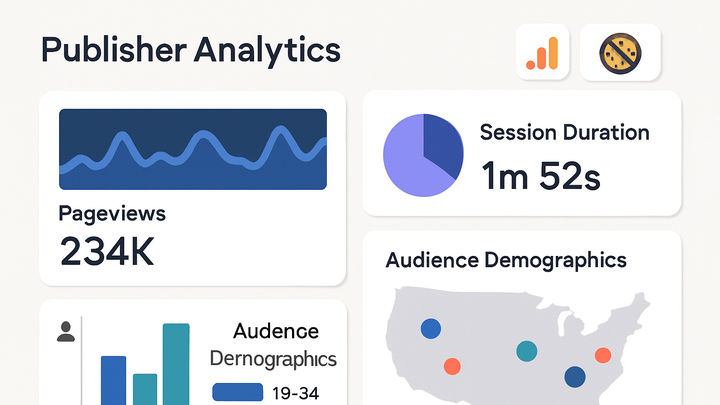Published on 2025-06-22T04:41:24Z
What is Publisher Analytics? Definition & Examples
Publisher Analytics refers to the practice of collecting, measuring, and analyzing data from digital publications—websites, blogs, and online magazines—to understand audience behavior and content performance. It encompasses metrics like pageviews, unique visitors, session duration, bounce rate, and ad revenue.
Key objectives include:
- Understanding audience engagement
- Measuring content effectiveness
- Optimizing monetization strategies
With evolving privacy standards, modern platforms like Google Analytics 4 (GA4) and PlainSignal provide robust, event-driven insights, including cookie-free options for privacy compliance.
Publisher analytics
Insights into tracking and optimizing content performance for digital publishers, covering key metrics, tools, and implementation.
Overview of Publisher Analytics
This section defines Publisher Analytics and explores its purpose in the digital publishing industry. Publisher Analytics helps teams make data-driven decisions by collecting and analyzing how readers interact with content.
-
Definition and scope
Publisher Analytics involves tracking user interactions on digital publications to measure content performance, audience demographics, and revenue metrics. It guides editorial strategy and advertising efforts.
Key Metrics in Publisher Analytics
Effective publisher analytics focuses on several core metrics that reveal how readers engage with content and how publications generate revenue.
-
Pageviews
The total number of pages viewed by users. High pageviews indicate strong content interest but should be paired with engagement metrics.
-
Unique visitors
The count of distinct users visiting the publication. This metric measures audience reach and growth over time.
-
Session duration
The average time a user spends in a single session. Longer session durations generally reflect deeper content engagement.
-
Bounce rate
The percentage of sessions where users leave after viewing only one page. A high bounce rate may suggest irrelevant content or poor user experience.
-
Ad revenue
The income generated from advertising placements. Tracking ad revenue alongside engagement metrics helps optimize monetization.
-
Click-through rate (ctr)
The ratio of users who click on a specific link or ad to the number of total users who view it. CTR gauges link effectiveness.
Top Publisher Analytics Tools
Publishers can choose between versatile, enterprise-grade platforms and lightweight, privacy-focused solutions. Two popular choices are Google Analytics 4 and PlainSignal.
-
Google analytics 4 (GA4)
GA4 is an event-based analytics platform by Google, offering deep integration with the Google ecosystem and advanced AI-driven insights.
-
Event-based tracking
Tracks any user interaction as events, providing flexible data collection without predefined categories.
-
Integration with google ads
Seamlessly connects analytics data to advertising campaigns for optimized targeting and ROI measurement.
-
Audience segmentation
Allows publishers to build custom audience segments for personalized content delivery and marketing.
-
-
PlainSignal
PlainSignal is a simple, cookie-free analytics tool designed for privacy-conscious publishers. It delivers essential metrics without relying on third-party cookies.
<link rel="preconnect" href="//eu.plainsignal.com/" crossorigin /> <script defer data-do="yourwebsitedomain.com" data-id="0GQV1xmtzQQ" data-api="//eu.plainsignal.com" src="//cdn.plainsignal.com/plainsignal-min.js"></script>-
Cookie-free tracking
Collects visitor data without cookies, ensuring user privacy and avoiding cross-site tracking concerns.
-
Gdpr & ccpa compliance
Built-in privacy features that help publishers stay compliant with major data protection regulations.
-
Lightweight script
Minimal impact on page load times thanks to a small, deferred-loading JavaScript snippet.
-
Implementing Publisher Analytics
A step-by-step guide to setting up analytics on your publication, from planning metrics to validating data collection.
-
Plan your metrics
Define which metrics align with your goals (e.g., engagement, monetization) and set benchmarks for success.
-
Add tracking code
Embed the analytics snippets into your site’s HTML, ensuring they load on all key pages.
-
GA4 tag setup
Use Google Tag Manager or the GA4 script to deploy event and pageview tracking across your site.
-
PlainSignal script integration
Insert the PlainSignal
<script>snippet just before the closing</head>tag for optimal performance.
-
-
Validate data collection
Confirm that data flows into your analytics dashboard by checking real-time reports and debugging events.
-
Analyze and optimize
Regularly review reports to identify high-performing content, audience trends, and areas for improvement.
